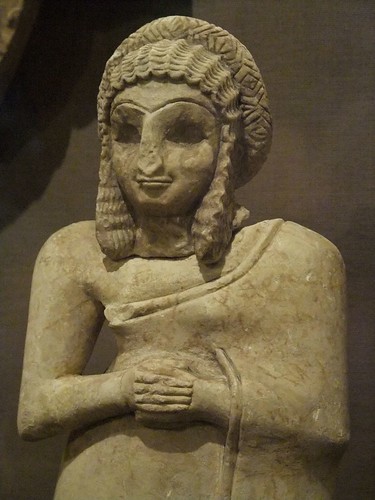
It is always exciting when an ancient intact tact tomb is discovered, especially one over 4,000 years old like this Canaanite tomb unearthed in Bethlehem.
[Image - Although not specifically Canaanite, this Early Dynastic Period figurine of a woman, discovered at Tell Asmar, part of the collection of the Oriental Institute at the University of Chicago, is only a few centuries older than the discovered tomb and probably reflects the dress and hairstyle of women from this period in the ancient Near East. Photo by Mary Harrsch.]
Workers renovating a house in the traditional town of Jesus’ birth accidentally discovered an untouched ancient tomb containing clay pots, plates, beads and the bones of two humans, a Palestinian antiquities official said Tuesday.
The 4,000-year-old tomb provides a glimpse of the burial customs of the area’s inhabitants during the Canaanite period, said Mohammed Ghayyada, director of the Palestinian Authority’s Ministry of Tourism and Antiquities.
Workers in a house near the Church of the Nativity uncovered a hole leading to the grave, which was about one meter (yard) below ground, he said. They dated the grave to the Early Bronze Age, between 1,900 B.C. and 2,200 B.C. - More: Azstarnet.com
This last statement is a little confusing as the Canaanite Middle Bronze Age I encompasses the dates indicated. Perhaps different scholarly groups name the periods differently. Anyway, this shaft tomb appears to be a typical semi-nomadic burial of a nuclear family.
The EB IV [Early Bronze Age IV Period] should be seen as the phase during which the process of the desertion of the towns [of Canaan] reached its peak; some of the towns had been abandoned during the EB III b, and others were abandoned during this phase. By the end of the EB IV, there were no urban settlements left in Canaan (Gophna 1992: 126 ff.). What were the motives of the decline of urban culture? Three different approaches of the events in Canaan during this period have been proposed. Some scholars consider that a wave of northern invaders (part of the Amorite migration to his area) or a campaign of Egyptian Fifth Dynasty kings was responsible for the destruction of the towns. The undestroyed sites would have been abandoned in terror.The second approach prefers an ecological point of view, pointing to data indicating a decrease in rainfall and a lowering of the water level, which would have doomed many settlements.Finally, others see the city-state system destroyed by friction and disagreement, a result of the constant warfare between the city-states evidenced in the repeated destructions and reconstructions visible in the EB II-III layers.Presently, it seems that an approach integrating the three explanations, along with additional reasons (trade, symbiosis, and cooperation), should be preferred in explaining the end of urban culture. - More: Sociedad De Estudios De Historia Antigua
I couldn't tell from the description, though, if this was a primary or secondary burial as the article did not state whether the bones were found "collected" or in an extended or flexed position as has been the case in primary burials excavated previously. The modest grave goods were consistent with a burial of this period.
The burial gifts interred in the Intermediate Bronze Age tombs do not excel in wealth. The typical offering consists of personal ornaments (metal pins, bracelets, and beads), pottery vessels, metal (copper) tools and weapons (a dagger or a spear). - More: Sociedad De Estudios De Historia Antigua
No comments:
Post a Comment